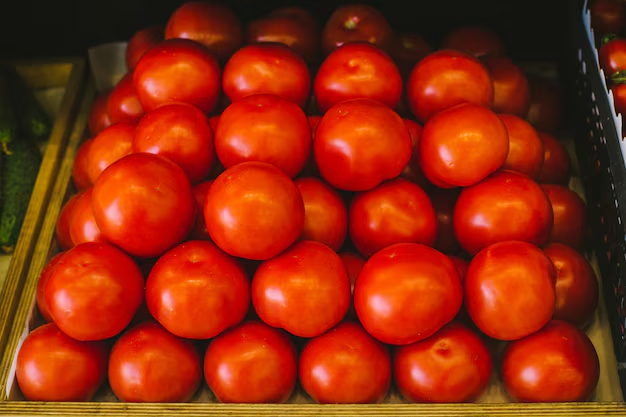Should You Store Tomatoes in the Refrigerator? The Definitive Guide to Tomato Storage and Shelf Life
Tomatoes are a beloved staple in kitchens around the world, cherished both for their rich flavor and vibrant color. When it comes to storing them, though, there seems to be an ongoing debate around one crucial question: Should you or shouldn’t you keep tomatoes in the refrigerator? Here, we dive into this topic, exploring the nuances of tomato storage to help you make informed decisions that will keep your tomatoes fresh and tasty for as long as possible.
🍅 Why Tomato Storage Matters
Tomatoes are versatile, appearing in salads, sauces, salsas, and much more. Proper storage is key to preserving their flavor, nutrients, and texture. Incorrect storage can lead to bland taste and mushy texture, robbing your culinary creations of their potential delight. Understanding the science behind tomato ripening and storage can give you a head start in maintaining their flavor and texture balance.
How Tomatoes Ripen
The journey of a tomato from vine to table involves a fascinating process of ripening. Ethylene gas, a natural plant hormone, plays a critical role in this transformation, turning tomatoes from an inedible green to a juicy red as it enhances the development of sugar and carotenoids.
The level of ripeness when you purchase or harvest your tomatoes should heavily influence your storage methods:
- Green or Underripe Tomatoes: Best stored at room temperature until they begin to redden.
- Vine-Ripened Tomatoes: If already ripe, they require careful attention to maintain their peak flavor and texture.
🥶 The Refrigerator Debate
The refrigerator can be both a friend and foe to your tomatoes. Understanding when and why to refrigerate is crucial.
Pros of Refrigerating Tomatoes
- Extended Shelf Life: Slows down the ripening process, ideal if you're not using ripe tomatoes immediately.
- Temperature Consistency: Protects ripe tomatoes from temperature fluctuations that might occur if left on the counter.
Cons of Refrigerating Tomatoes
- Flavor Loss: Cooler temperatures can mute the tomato’s natural taste by impacting the complex flavor compounds.
- Texture Changes: Refrigeration may alter the tomato’s texture, often resulting in a mealy consistency that is less pleasing in raw applications.
Expert Perspectives
A consensus among culinary experts suggests that tomatoes are best kept at room temperature until fully ripe. Once they hit peak ripeness, storing them in the refrigerator is acceptable, but it should only be for a short period to slow down further ripening and spoilage.
🏡 Room Temperature Storage
For unripe or near-ripe tomatoes, room temperature storage is ideal. Here are some practices to optimize their shelf life:
Ideal Conditions
- Humidity: Moderate (not too dry or too moist) conditions can help maintain tomato integrity.
- Air Circulation: Ensure there's good air flow to prevent mold growth and promote even ripening.
Tips for Home Storage
- Countertop Storage: Lay tomatoes stem-side down to prolong freshness and protect the internal texture.
- Tissue Protection: Use a single layer of paper towel to cushion tomatoes, reducing impact damage and absorbing excess moisture.
🍳 Tomato Usage and Culinary Considerations
The way in which you plan to use your tomatoes can dictate the preferred storage method.
Raw vs. Cooked Applications
- Raw Dishes: For salads or sandwiches, vine-ripened tomatoes stored at room temperature deliver optimal flavor.
- Cooked Recipes: Refrigerated tomatoes, while slightly altered in texture, are perfectly suitable for recipes where their structural integrity is less critical, like sauces or stews.
Here's a practical summary for fast decision-making:
| Storage Situation | Recommendation |
|---|---|
| Green/Underripe Tomatoes | Store at room temperature |
| Ripe Tomatoes (Short Term) | Refrigerate to prevent spoilage |
| Ripe Tomatoes (Immediate Use) | Countertop for flavor optimization |
📋 Tomato Storage Tips & Tricks
To encapsulate our exploration, here’s a quick, skimmable list of takeaways for maintaining your tomatoes in peak condition:
- 🌿 For Flavor: Store unripened tomatoes on the counter until they're ready to eat.
- 🧊 For Longevity: Place fully ripe tomatoes in the fridge but consume within a few days for best texture.
- 👌 Judge by Need: Your storage choice hinges on when you plan to use them. Plan for usage within a few days for refrigerated tomatoes.
- 🔍 Check Regularly: Inspect your stock every day for any signs of spoilage.
🌟 Beyond the Basics: Exploring Further
Tomatoes are fascinating beyond just storage. Here’s how you can further engage with your favorite fruit:
Varietal Considerations
Different varieties may react differently to storage choices. Experiment with heirloom, Roma, and cherry tomatoes to see personal preference in tastes and textures.
Growing Your Own
For the green thumbs out there, growing your own tomatoes gives you complete control over their ripening process – nothing beats a homegrown, sun-ripened tomato!
Perfect Tomato, Every Time
To sum up, how you decide to store your tomatoes has a meaningful impact on their flavor and longevity. By understanding the nuances of tomato storage—considering factors like ripeness, intended use, and environmental conditions—you can enjoy the fresh, bright taste of tomatoes just as nature intended. Whether on a sandwich, in a salad, or as a flavorful sauce, with these guidelines, your tomatoes will always be ready to impress.
